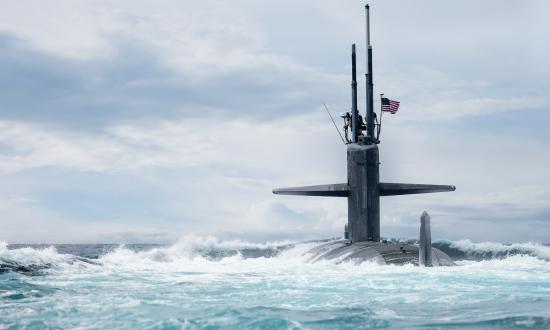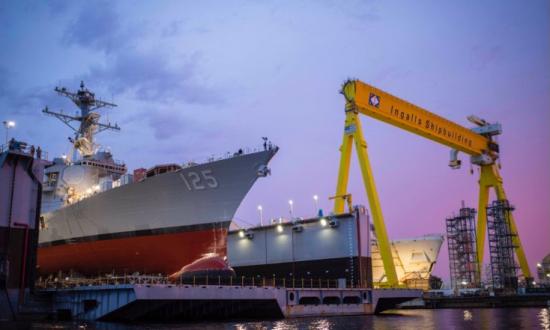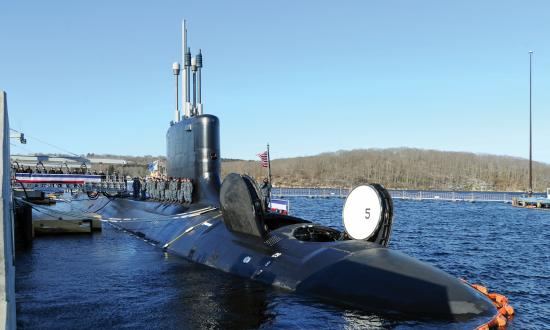On 6 October 2020, Secretary of Defense Mark Esper outlined his “Battle Force 2045” initiative, which included building up to 500 ships and increasing the production rate of Virginia-class attack submarines (SSNs) to three per year, up from the Navy’s existing goal of two per year.1 The plan sparked questions about the costs to build, maintain, and man this larger force, as well as whether the U.S. industrial base had the capacity to produce it.2 These are valid points, and political will and budget compromises may not allow realization of Battle Force 2045 in its entirety, but policy-makers would be wise to consider the increased SSN production rate as a budget-wise way to invest in asymmetry, thwart antiaccess capabilities with existing technologies, and outpace the People’s Republic of China to maintain an overmatch in the undersea domain—a domain still highly dominated by the United States.
Numbers Matter. According to a 2020 Congressional Research Service report, given the decommissioning rate of Los Angeles-class SSNs, the submarine force will drop from 52 boats to a low point of 42 in fiscal years 2027 and 2028 before climbing back to the current goal of 66 in 2048.3 Accelerating Virginia-class production by one additional SSN per year would achieve the 66-boat goal in 2036, assuming the first additional unit were delivered in 2029 (a plausible time frame to increase output capacity). This acceleration would reduce the time that inventory is less than goal by 12 years, likely with corresponding benefits to readiness, retention, and operational days.
As the 2020 report indicates, “Some observers are concerned that this projected valley could lead to a period of heightened operational strain for the SSN force, and perhaps a period of weakened conventional deterrence against potential adversaries such as China.”4 An important question for policy-makers in the era of great power competition is not, Can we afford to increase SSN production rate? But rather, Can we afford not to?
Asymmetry Returns. It might be hard to imagine a $3.4 billion SSN could be considered a bargain, but given the asymmetric results an SSN can deliver, the cost-benefit calculus favors the investment.5 Submarines are inherently asymmetric, as they can inflict a large amount of destruction at relatively low cost and risk. This statement is not anecdotal. A 1999 analysis by Michel Poirier concluded the United States inflicted extremely high costs on the Japanese Navy and economy through the submarine campaign of World War II. Specifically, the “Japanese spent at least 42 times more in Anti-Submarine Warfare and in losses attributed to submarines than the U.S. spent on her Submarine Force.”6 Japan’s costs included merchant ships and cargo lost, as well as the cost of the fleet used to protect shipping and losses in efficiency from convoys and other mitigation measures.
Today’s nuclear-powered submarines are more expensive to build than World War II submarines, but the size and complexity of potential targets has increased as well. Based on their destructive capabilities and (relatively) low cost, U.S. submarines remain a formidable asymmetric threat.
This historical example is specific to a strategy of maritime trade warfare (which still could be a feasible option), so Poirier’s 42 to 1 cost balance could be overstating the SSN’s asymmetric capabilities if the United States sought to target only People’s Liberation Army Navy (PLAN) shipping in a conflict. However, the maritime nature of the area and the likely need for China to transport forces and logistics to an offshore objective leaves an Achilles heel for the U.S. submarine force to target, even if the benefits are not quite 42 to 1.
Unseen Deterrence. By their stealthy nature, submarines have the capability not just to impose high costs, but also to deter in an asymmetric manner. Submarines can deter adversary activity in an area even if they are not actually in the area. This allows an outsized or asymmetric effect to be realized. During the Falklands conflict, once HMS Conqueror sank the Argentine cruiser General Belgrano, the remainder of the Argentine Navy returned to port and essentially was no longer a factor in the conflict.7 Because the location and numbers of Royal Navy submarines were unknown, the Argentine Navy could not calculate an unknowable cost and was unwilling to risk further destruction to its fleet.
In a potential future conflict, China might be willing to accept more risk and losses than the Falklands example demonstrates; however, the key to using the SSN in this role is that costs do not actually need to be imposed in the proportional sense to obtain results. Deterrence theorists explain that deterrence stems from capability, credibility, and communication.8 That is, to deter effectively, a force must be materially capable of carrying out the threat, it must be willing to do so, and the threat must be communicated or demonstrated to the adversary.
Given the inherently maritime nature of a possible future conflict with China, SSNs are uniquely suited to achieve a higher level of deterrence with smaller numbers than other U.S. platforms. Specifically, as with the Falklands example, destroying PLAN vessels would establish credibility and communicate U.S. intentions. But because of submarines’ stealthy nature, the true capability of the U.S. submarine force would remain unknown to Chinese decision-makers. This masking of numbers and locations provides an asymmetric deterrence capability.
Strength against Weakness. A possible U.S. strategy in a future conflict with China could be to inflict rapid and high costs on the PLAN to prevent a quick seizure of a contested land mass in a fait accompli. U.S. SSNs could play an essential role in this strategy, both by imposing high direct costs on China and by altering its planning assumptions about costs through unseen deterrence. Both roles capitalize on asymmetry. This does not mean there should be fewer aircraft carriers, surface combatants, aircraft, or unmanned platforms, but rather that accelerated production of SSNs would be a cost-effective means to achieve asymmetric results. Submarines have proven their value in delivering outsized results using strategies of attrition and conventional deterrence. While a future potential conflict with China is likely to be very different from the historical examples, there is no reason to assume submarines will not play a central role.
Opponents of increasing the submarine portion of the shipbuilding budget will likely and rightfully argue that based on the SSN’s shorter sensor horizon, inability to influence the air domain, and constrained communication connectivity, only surface combatants and aircraft carriers can truly execute sea control. While this position has merit, it also is true that surface platforms can control only that area they are able to access. China’s growing antiaccess/area-denial (A2/AD) capabilities have pushed this area significantly further east, away from the Chinese mainland.
A 2017 RAND Corporation study comparing U.S. and Chinese military “scorecards” noted that China’s A2/AD capabilities are capable of “greatly complicating the task of operating a fleet within several thousand kilometers of the Chinese coast, at least during the initial stages of a conflict.”9 This initial stage is when access is most essential in preventing a fait accompli. The study further sates that “China’s growing force of sophisticated ballistic and cruise missiles increasingly place U.S. military forces on the wrong end of a cost-imposition calculus.”10 U.S. submarines can right this imbalance.
China is likely to continue developing A2/AD capabilities to pit its strength against a U.S. critical vulnerability: the targetability of surface platforms that can be ranged from China. Why should U.S. defense planners play into the hands of China in this area? The United States does not need to wait for future technologies to defeat China’s A2/AD capabilities: It has existing and proven technologies that can capitalize on U.S. strength in the undersea domain and pitch this against Chinese weakness in antisubmarine warfare. In doing so, it can follow Sun Tzu’s advice to “avoid what is strong and strike at what is weak.”11
1. Mark Esper, “CSBA Fireside Chat with Secretary of Defense Mark Esper,” Center for Strategic and Budgetary Assessments webinar, 6 October 2020.
2. Harlan Ullman, “Battle Force 2045 Raises Important Questions,” U.S. Naval Institute Proceedings 146, no. 10 (October 2020).
3. Ronald O’Rourke, Navy Virginia (SSN-774) Class Attack Submarine Procurement: Background and Issues for Congress, CRS Report No. RL32418 (Washington, DC: Congressional Research Service, 2020), 3.
4. O’Rourke, Navy Virginia (SSN-774) Class Attack Submarine Procurement, summary.
5. O’Rourke, 5.
6. Michel T. Poirier, Results of the German and American Submarine Campaigns of World War II (Office of the Chief of Naval Operations, Submarine Warfare Division, 1999).
7. Max Hastings and Simon Jenkins, The Battle for the Falklands (New York: W. W. Norton & Company, 1983), 149.
8. Robert P. Haffa, “The Future of Conventional Deterrence: Strategies for Great Power Competition,” Strategic Studies Quarterly 12, no. 4 (2018): 94–115.
9. Eric Heginbotham et al., The U.S.-China Military Scorecard: Forces, Geography, and the Evolving Balance of Power, 1996–2017 (Santa Monica, CA: RAND Corporation, 2017), 153.
10. Heginbotham et al., The U.S.-China Military Scorecard, 46.
11. Sun Tzu, The Art of War (Minneapolis: Filiquarian Publishing, 2006), 34.






